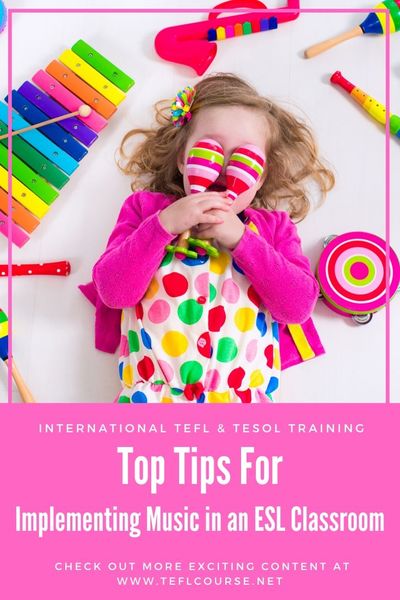Implementing Music in an ESL Classroom

There are many reasons that using songs in the classroom is important. The first, music speeds up learning. The 1960s was the moment when scholars began to examine the possibility of increasing memory abilities with music.
Table of Contents
Do you want to teach English abroad? Take a TEFL course!
This post was written by our TEFL certification graduate Huong T. Please note that this blog post might not necessarily represent the beliefs or opinions of ITTT.
Research in the Field
A series of creative experiments performed by Dr. Georgi Lozanov and Evelyna Gateva and their findings revolutionized teaching methodology. It initiated the whole brain learning method called Accelerated Learning. Knowledge about human learning processes gained during the trial sessions of the method is of great interest to teachers looking for ways of introducing music to their classrooms. Background music was used during various learning tasks in two ways. There was the Active Concert aiming to activate the learning process mentally, physically and emotionally. Then there was the Passive Concert to place students in the relaxing alpha brain wave state and help them to stabilize their mental and physical rhythms.
Both methods are excellent for improving information absorption and together stand as a popular and powerful strategy for providing learning experiences that are far more efficient. The second, music helps students to memorize learning material. When accompanied by music new information becomes easier to remember. Students can connect particular data to a rhythm, and then use their memory of musical elements to recall the information following their association. Teachers have been using songs, chants, poems, and raps for a long time now and learned that they work. How do we teach children the alphabet? By adding a melody. Melodies, rhymes or rhythms help students to memorize the content of musical pieces.

Also Read: How much can I earn teaching English in Italy?
In classroom
Instructors can take the method further and instead of providing their musical pieces to perform, they can ask students to write their lyrics for specified content. With the regular performance of the chant, teachers can help students of all ages to recall and retain new information. The third, music enriches learning experiences. Many teachers use music to serve as a soundtrack for various activities because it increases the interest of students in the learning material. By activating the information emotionally, physically and mentally, the multi-sensory interaction with information can help teachers to create a highly focused learning state. This is where students can quickly absorb a lot of information. Instructors can start their adventure with classroom music by reading a summary of the class topic (with key facts and figures) with appropriate music in the background. To students, this otherwise boring summary will now seem like a trailer to a fantastic movie – the plot of which will unfold during the lesson. A dramatic musical piece will also help them to remember those bits and pieces of information. The fourth, music motivates students to focus.
Also Read: What is the EPIK program for teaching English in South Korea?
Other purposes to use music
Another great function of music in the classroom is that it impacts human emotions and mental states. It can set a rhythm to help students achieve a greater state of concentration. A focused learning experience is the best solution for processing and memorizing more information than in standard learning environments. A focused atmosphere can be achieved with the structural Baroque music, for instance, pieces composed by Handel, Bach or Telemann. In essence, those pieces should be characterized by 50 to 80 beats per minute. Experts claim that absorbing new information or reading is more efficient with Bach playing in the background. Mozart comes in handy during afternoon sessions when students are usually tired and lack motivation.
The fifth, music builds a supportive atmosphere. Music helps teachers to create the right atmosphere in the classroom, supporting and motivating students to work hard, sparking their interest in learning tasks and helping them to focus. Music can wake up a sleepy classroom. If your students are restless and cannot focus, music can calm them down and provide them with a source of mental balance. It's a good idea to play a tune when students are entering the classroom – it will set the right atmosphere from the very beginning, welcoming students to participate in your learning experience and providing them with structures of support. The sixth, music creates a sense of community. This is something that not many instructors realize about music. Playing specific background music in the classroom can help them in sorting out and stimulating the social atmosphere. Music can create a positive environment, assisting students in developing a sense of community and building the first steps towards smooth group collaboration.

Also Read: How do I get a job teaching English in Japan?
Group work
Groups of students can work together and develop a classroom theme song to build a strong community experience. Moreover, people bond and become more emphatic towards each other with music. Music can become a factor in opening your students' minds to different cultures and different perspectives. The seventh, music fosters individual expression and stimulates creativity.
Finally, instructors should not forget that music provides excellent stimulation for further creativity. Even if they don't boast musical education, students can still create musical pieces of their own. Inspiring students to write songs about the learning material will allow them to express their feeling about it and develop a bond with it, perfect for memorization. Instructors often use musical pieces to set a certain mood in the classroom – and we know that moods can be powerful in boosting the reception of the learning material. You can benefit from music in creative role-play activities, where students use it together with movement to visualize abstract information. Music is such a versatile tool that offers opportunities for improvement in many aspects of the classroom.
Do you want to teach English abroad? Take a TEFL course!
Using music as a part of classroom activities, instructors will simply provide their students with a more engaging learning experience – and engagement is the key ingredient for knowledge processing and retention. Summary, Using the songs in the classroom is a necessary and indispensable activity for both teachers and students.
Apply now & get certified to teach english abroad!
Speak with an ITTT advisor today to put together your personal plan for teaching English abroad.
Send us an email or call us toll-free at 1-800-490-0531 to speak with an ITTT advisor today.
Related Articles:
- Where to Earn the Highest Salaries Teaching English Abroad
- The Benefits of Having Good Rapport with Students
- 10 Questions You Need to Ask Before Enrolling In a TEFL Course
- What It's Like To Teach English Online: An Online Teacher Reveals Her Secrets!
- 4 Super Easy Tips for Teaching Vocabulary to Young Learners
- Getting Student Placement Right - The Best Desk Arrangements for EFL Students




